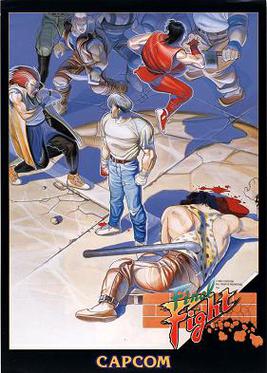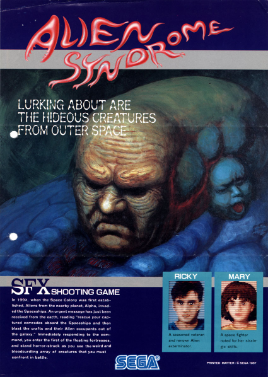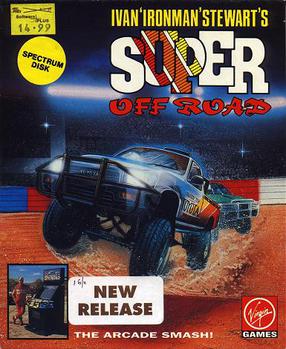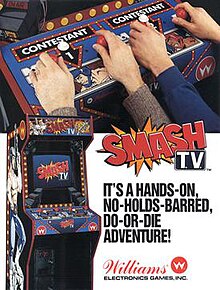
NBA Jam is a basketball video game developed and published by Midway for arcades in 1993. It is the first entry in the NBA Jam series. The project leader for this game was Mark Turmell.

Final Fight is a side-scrolling beat-'em-up video game produced by Capcom. Originally released as an arcade game in 1989, it was the seventh title released for the CP System hardware. Set in the fictional Metro City, the game lets the player control one of three street fighters: former pro wrestler and city mayor Mike Haggar, expert brawler Cody Travers, and modern-day ninja Guy. The trio set out to rescue Jessica when she is kidnapped by the Mad Gear Gang.

Alien Syndrome is a run and gun video game developed by Sega and released in arcades in 1987, and later ported to the Master System in 1988. The game utilizes a side-scrolling feature that allows the player to take control of either a male (Ricky) or female (Mary) soldier whilst hunting aliens and saving hostages before they run out of time.

Defender is a horizontally scrolling shooter video game developed by Williams Electronics in 1980 and released for arcades in 1981. The game is set on either an unnamed planet or city where the player must defeat waves of invading aliens while protecting astronauts. Development was led by Eugene Jarvis, a pinball programmer at Williams; Defender was Jarvis's first video game project and drew inspiration from Space Invaders and Asteroids. Defender was demonstrated in late 1980, before entering production in early 1981. It was distributed in Japan by Taito.

Robotron: 2084 is a multidirectional shooter developed by Eugene Jarvis and Larry DeMar of Vid Kidz and released in arcades by Williams Electronics in 1982. The game is set in the year 2084 in a fictional world where robots have turned against humans in a cybernetic revolt. The aim is to defeat endless waves of robots, rescue surviving humans, and earn as many points as possible.

Super Sprint is a racing video game released by Atari Games and Midway Games in 1986. Up to three players drive Formula One-like cars on a circuit that is viewed from above. The game is a successor to Gran Trak 10 and the Sprint series, which were black-and-white games from the 1970s. A sequel, Championship Sprint, was released later in the same year.

Paperboy is an arcade action game developed and published by Atari Games, and released in 1985. The player takes the role of a paperboy who delivers a fictional newspaper called The Daily Sun along a street on his bicycle. The arcade version of the game featured bike handlebars as the controller.

Krome Studios Melbourne, originally Beam Software, was an Australian video game development studio founded in 1980 by Alfred Milgrom and Naomi Besen and based in Melbourne, Australia. Initially formed to produce books and software to be published by Melbourne House, a company they had established in London in 1977, the studio operated independently from 1987 until 1999, when it was acquired by Infogrames, who changed the name to Infogrames Melbourne House Pty Ltd.. In 2006 the studio was sold to Krome Studios.

Operation Wolf is a light gun shooter arcade game developed by Taito and released in 1987. It was ported to many home systems.

Operation Thunderbolt is a light gun shooter video game developed by Taito and released for arcades in 1988. As the sequel to Operation Wolf, changes include two-player gameplay with two positional gun controllers mounted on the arcade cabinet, and a new forward-scrolling pseudo-3D perspective combined with side-scrolling sections.

Midway Arcade Treasures is a video-game compilation of 24 arcade games, emulated from the original PCBs. The overall release was developed by Digital Eclipse and issued by Midway for the PlayStation 2, Xbox, GameCube, and Microsoft Windows.

Ivan "Ironman" Stewart's Super Off Road is an arcade video game released in 1989 by Leland Corporation. The game was designed and managed by John Morgan who was also lead programmer, and endorsed by professional off-road racer Ivan Stewart. Virgin Games produced several home versions in 1990. In 1991, a home console version for the Nintendo Entertainment System was later released by Leland's Tradewest subsidiary, followed by versions for most major home formats including the Master System, Genesis, Super NES, Amiga, and MS-DOS. A port for the Atari Jaguar was announced but never released. Some of the ports removed Ivan Stewart's name from the title due to licensing issues and are known simply as Super Off Road.

Total Carnage is a multidirectional shooter arcade video game originally developed and published by Midway in North America in January 1992. Set in the fictional country of Kookistan during 1999, players assume the role of Captain Carnage and Major Mayhem from the Doomsday Squad in a last-ditch effort to overthrow dictator General Akhboob and his army of mutants from conquering the world, while also rescuing POWs held by his military force.

WWF WrestleMania is a professional wrestling arcade game released by Midway Manufacturing Co. in 1995. It is based on the World Wrestling Federation (WWF) professional wrestling promotion.
Blaster is a first-person rail shooter video game, released for arcades by Williams Electronics in 1983. It was developed by Eugene Jarvis and Larry DeMar. A vague sequel to Robotron: 2084, the game is a shoot 'em up set in outer space. The goal is to destroy enemies, avoid obstacles, and rescue astronauts in twenty levels, to reach paradise.

Forgotten Worlds, titled Lost Worlds in Japan, is a side-scrolling shooter video game by Capcom, originally released as a coin-operated arcade game in 1988. It is notable for being the first title released by Capcom for their CP System arcade game hardware.

Thunder Blade is a third-person shoot 'em up video game released by Sega for arcades in 1987. Players control a helicopter to destroy enemy vehicles. The game was released as a standard stand-up arcade cabinet with force feedback, as the joystick vibrates. A helicopter shaped sit-down model was released, replacing the force feedback with a cockpit seat that moves in tandem with the joystick. It is a motion simulator cabinet, like the previous Sega Super Scaler games Space Harrier (1985) and After Burner (1987). The game's plot and setting was inspired by the film Blue Thunder (1983).

Midway Arcade Origins is an arcade compilation released on November 6, 2012, in North America and in Australia. It is the successor to the Midway Arcade Treasures series, and includes a selection of games that were included in those compilations, with the sole exception of Vindicators Part II. Midway Arcade Origins was added to the Xbox One via the backwards compatibility program.
Twin-stick shooter is a subgenre of shoot 'em up video games. It is a multidirectional shooter in which the player character is controlled using two joysticks: the first for movement on a flat plane and the second to shoot in the direction the joystick is pushed. Usually shots are fired as soon as the second joystick is moved, but in some games there is an additional button which must be held. Keyboard and mouse or touch input may supplant one or both joysticks. A few games, such as 1981's Vanguard, don't have a second joystick for shooting, but provide four buttons arranged in a diamond to fire in the cardinal directions.


















